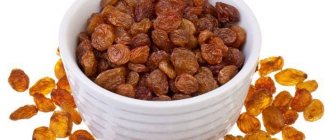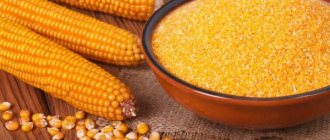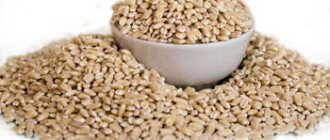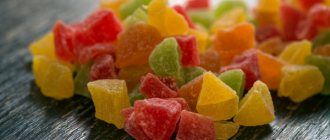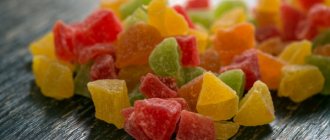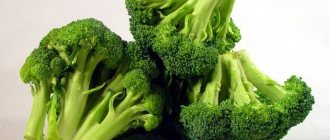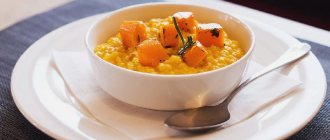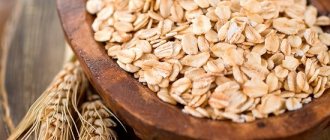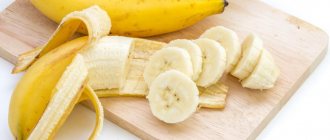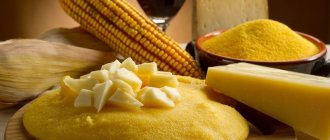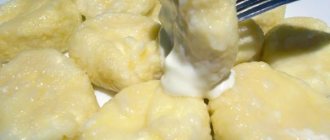Mamalyga, gomi, basta, banush, polenta - this is how corn porridge is called in different countries. And if for many peoples this is a national dish, then in our country it is inferior in popularity to other types of porridges. But this is not just a tasty, but also a very healthy dish, which should definitely take its rightful place on our table.
Nutritional value and chemical composition
The nutritional value of corn grits is higher than that of unprocessed grains. The processing process includes cleaning the grains from various kinds of films formed during the ripening of the fruit. This type of cereal has the lowest indicators for the presence of a vitamin-mineral complex, but despite this, it does not lose its importance in the human diet.
Nutritional value and chemical composition
Value indicators for 100 g of dry porridge:
- Nutritional/Energy value – 1587 kJ, 379 kcal.
- Dietary fiber – 3 g.
- Proteins – 7 g.
- Fats – 1 g.
- Carbohydrates – 84 g.
- Sodium – 18 mg.
- Iodine – 70 mcg.
- Iron – 7 mg.
- Zinc – 4 mg.
- Calcium – 440 mg.
- Vitamin C – 50 mg.
- Vitamin A – 390 mcgPE.
- Vitamin D – 9 mcg.
- Vitamin E – 7.5 mg.
- Vitamin B1 – 0.25 mg.
- Vitamin B2 – 0.5 mg.
- Vitamin B6 – 0.3 mg.
- Vitamin B9 – 70 mcg.
- Vitamin PP – 4.5 mg.
- Phosphatides.
- Cobalt.
- Copper.
- Phosphorus.
- Potassium.
- Chromium.
The indicated values of the elements are subject to change during the preparation of cereals: with milk, with water, with steam.
Amino acids included in the cereal:
- Aromatic alpha amino acid.
- Aliphatic (lysine).
- Heterocyclic alpha amino acid.
- Arginine.
Aminocarboxylic acids are involved in protein synthesis in the human body. Containing iron and copper, they participate in the process of blood renewal and normalize hemoglobin levels. If the human body does not receive enough meat products, then the protein intake can be compensated with the help of corn grits.
The best cereal producers
In Russia, the cereal products market is stable and has good growth dynamics. The best manufacturers operating on a wholesale scale are leading Russian companies and holdings.
- Agapov Company
It has been operating in the market of cereal producers since 1998, specializing in the production of popular cereals, bran and waste for pet food.
All products are certified and meet the requirements of state standards. Products are regularly tested for quality control in the company's laboratories.
The company produces ground corn grits No. 4, corresponding to GOST 6002-69.
- TP Ambarel Company
The company's products participate in agricultural exhibitions at the republican and all-Russian levels, where they receive prizes for the quality of their products.
The production facilities produce and sell two types of corn grits – white and yellow.
White cereals contain a large amount of protein, while yellow cereals contain a lot of carotene. The products are packaged in polypropylene bags weighing 800 g.
- Raduga Group of Companies
The company produces and sells corn processing products; annual volumes reach one hundred thousand tons.
The production complex is equipped with the best modern equipment, which produces a large volume of products sold on the domestic market and in neighboring countries.
The company produces three types of cereals, all of which comply with established government standards. The products have a high content of proteins (up to 8.3%) and carbohydrates. Humidity does not exceed 15%.
Types of cereals
The appearance of the cereal is yellow or white. The smell of the crushed cereal remains the same as that of fresh corn.
Types of cereals
Cereal division criteria:
- Processing method for corn grain.
- Grain size.
Corn grits, the benefits and harms of which are studied in detail by nutritionists, are divided into 3 types:
- Large.
- Polished.
- Small.
- Polished corn grits. The composition includes crushed particles of the grain kernel of a cereal plant. During processing, fruit shells and germs are separated from the grain. During processing, the grain becomes rounded and polished. This species is divided into 5 subspecies. The number indicates the size of the resulting particle; the larger the grind number, the smaller the processed grain. The size of the grains varies from 0.6 to 4 mm.
- Large corn grits. The resulting particles come in different shapes during processing. The processing process consists of separating the fruit shells and germ from the grains. The size of grains of this type varies from 5 to 7 mm. Large grains are used in preparing breakfasts: flakes, puffed grains.
- Small corn grits. The processing process is the same as for large grains. A distinctive feature is the size of the resulting grains, the length of which varies from 0.7 to 1.2 mm. Used to make corn sticks.
Features of the cereal:
- Gluten free.
- Does not lose nutritional value during hot processing.
A little history
Corn is an ancient agricultural crop. Back in the fifteenth century, it was discovered in the European part of the world, and Columbus introduced America to corn almost 9 thousand years ago. There it became the basis of home nutrition, and the ancient Aztecs gave it the name maize.
In those distant times, corn cobs were very small, no more than 4 cm, which is 10 times smaller than modern types. The plant was domesticated on the territory of ancient Mexico, and later breeding work was carried out to increase the variety of crops. Now Mexico has many varieties of different sizes, tastes and colors - yellow, white, red, blue, and black cobs are famous.
Europe quickly learned to cultivate the plant; corn became especially widespread in countries located in the Mediterranean Sea. From there, in the seventeenth century, the grain crop came to Russia, where over time it became widespread. At first, they began to distribute its seeds free of charge to everyone who wanted them, then they encouraged ordinary traders to trade in boiled cobs. To do this, large vats were installed on the streets of different cities, corn was boiled in them and immediately sold to the townspeople. Thus, people began to be encouraged to grow this crop.
Today, corn grows throughout the vast territory of the Russian Federation and is widely popular among the population, because it is a filling, tasty and healthy snack and has healing properties.
The plant itself is considered environmentally friendly, its roots do not accumulate fertilizers, and chemical elements do not penetrate into the cobs.
Benefits for men and women
Corn grits, the benefits and harms of which depend on the methods of preparation, are in demand among people leading a healthy lifestyle.
Benefits for men and women
Benefits of corn grits:
- Cereal-based foods are rich in carbohydrates, so the released energy is enough for the body for a long period of time.
- Cleansing the digestive organs from accumulated harmful substances, toxins, and dense fecal formations.
- Used for preventive purposes for constipation.
- Eliminates fermentation in the intestines.
- Phosphatides contained in grains are involved in the biosynthesis of cholesterol. Regular consumption helps create elastic and strong vascular walls.
- The vitamins included in the composition are involved in strengthening nerve structures.
- Prevention of anemia.
- Strengthening the scalp.
- Strengthening the nail plate.
- Strengthening the immune system.
- Slowing down cell aging.
Despite the high calorie content, the product is considered dietary. Natural fats contained in porridge do not allow fats of other origin to be absorbed. Due to this, weight loss occurs and the body is cleansed. The diet using products based on corn grits is strict.
The duration of the diet is 5-7 days. The cereal is cooked in water without adding oil, salt or sugar.
In addition to porridge, the diet includes raw vegetables and fruits. Following a diet based on corn grits is not recommended for people suffering from gastrointestinal diseases during exacerbation. During the diet, weight decreases by 3-4 kg. Women use corn flour-based products not only for nutritional purposes, but also to relieve fatigue and rejuvenate.
The best porridge for weight loss
For weight loss, corn porridge will be an invaluable aid, because it is rich in slow carbohydrates. It contains 70% carbohydrates, 8% protein and only one and a half percent fat.
In addition, it contains a lot of fiber, which, like a natural brush, cleanses from the gastrointestinal tract all food breakdown products, pesticides that enter the body with vegetables and fruits, and much more. Fiber is especially important for the intestines, as it prevents the development of fermentation and putrefaction processes in it.
Corn porridge contains glutamic acid, which can normalize metabolic processes in the body. But proper metabolism is the key to not just losing weight, but also not gaining weight after that.
Corn grits support liver function, which is what many overweight people need. As a rule, they eat a lot of fried, sweet, salty, fatty and peppery foods, which cannot but affect the condition of this internal organ.
Corn porridge helps normalize hormonal levels, which is especially necessary for women who often begin to gain weight precisely because of hormonal disruptions. It is very good to introduce this product into the diet of teenagers when hormonal levels can “jump” due to changes in the body.
It is equally important for women to indulge in this porridge during menopause, which is also accompanied by problems with the endocrine system and hormonal imbalances.
| Properties of grains | Their effect on the body |
| They remove excess fluid from the body. | Thanks to this, puffiness and swelling are relieved. Porridge grains are able to bind free radicals and then remove them from the body naturally. |
| The ability of corn grits to clean the walls of blood vessels from cholesterol “thickets” is also beneficial for those losing weight. | Losing weight without exercise is difficult, and in order to exercise effectively, you need to keep your cardiovascular system working smoothly. |
| It is noteworthy that corn porridge helps to cope not only with slight excess weight, but even in cases where we are talking about obesity of varying degrees. | Here the main role is played by the factor of low energy value of corn dishes. The trick is that, with a low calorie content, porridge can quickly and, most importantly, satiate a person for a long time, thanks to the high content of slow carbohydrates in it. This means that with a low calorie intake and small portion sizes, a person will not feel hungry, and the risk of breaking the diet will be minimized. |
Also, weight does not gain from corn porridge due to the fact that the proteins included in its composition are not completely absorbed by the body.
But all the above advantages do not mean that you need to resort to a mono-diet and eat only corn porridge. This approach can actually harm your health! The ideal option is to include porridge in a complete diet menu.
During pregnancy and lactation
Pregnancy is a period when a woman needs twice as many vitamins. Corn porridge is an opportunity to get rid of problems with constipation, as pregnant women suffer from problems with the digestive system. Pregnant women suffering from gluten intolerance also include corn grits in their diet.
During pregnancy and lactation
Pregnant women often suffer from high blood sugar levels – gestational diabetes mellitus. In this case, cereal will become an additional opportunity to diversify the menu. Due to the fact that porridge is hypoallergenic, it is included in the diet during lactation. Its use will not harm either mother or child.
It is not recommended to introduce cereal into the diet if a woman suffers from hypercoagulation (blood clotting is increased and is a pathology). When a pathology is detected, the diet is prepared by a qualified specialist. With such a diagnosis, consumption should be limited not only to pregnant women, but also to people who are not pregnant.
For the body of infants and older children
The vitamin complex of corn grits for a child is poor. You should not limit yourself to eating only corn porridge; your diet needs to be varied. It is also necessary to take into account that this type of porridge contains a large amount of starch. Not all children tolerate starch.
It is impossible to exclude porridge from the diet, as it contains a sufficient amount of selenium for a child. When preparing dishes from corn grits, it should be steamed longer so that it is better absorbed by the body. You can use a ready-made option - instant baby porridge.
Based on the legislation of the Russian Federation and recommendations for baby nutrition, porridge based on corn grits is introduced into the menu for infants from 4 months.
If the child does not have an allergic reaction to corn grits, it can be prepared with the addition of other grains. Dry porridge is mixed with buckwheat, wheat, oatmeal, and rice cereals. Multigrain porridges are introduced from 6 months.
Cooking recipes
In order for corn porridge to retain all the original qualities and for the food to have a pleasant taste, it must be cooked according to certain rules. The most popular cooking recipes:
- With water. Boil 250 ml of water, add salt. Add 100 g of washed corn grits and 2 tbsp. l. sugar, mix. Cook the porridge over low heat for 20 minutes, stirring it occasionally with a spoon. At the end of cooking, add a slice of butter.
- In a slow cooker. Add 1 tbsp of cereal to the bowl of the device. and 2.5 tbsp water. Select the “Cooking porridge” mode. This dish is usually prepared within 30–40 minutes, and the finished product is soft and crumbly.
- Recipe for children. Prepare glass or clay dishes intended for use in the oven. Pour 100 ml of water and 100 ml of milk into a container, add 2 tbsp. l. corn granules Add salt to taste, add a pinch of washed raisins and a little sugar. Mix all the ingredients and place the container in an oven preheated to 180°C for half an hour. Then stir the porridge and simmer for about 15 minutes.
- With apples and milk. In a saucepan with a thick bottom, mix 1 tbsp. water and 2 tbsp. milk, bring to a boil. Add 1 tbsp. polished corn granules, simmer for 15 minutes. Salt the cereal to taste, add a pinch of sugar and vanilla. Cook the porridge for about 15 more minutes. Peel and seed, and then grate 2 apples. Before serving, add them to the pan with porridge and stir.
- For weight loss. Add 1 tbsp to the baking container. corn granules, 2 tbsp. l. olive oil and 100 g of washed raisins. Stir the cereal, add salt to taste. Pour all ingredients 2.5 tbsp. water, bake in an oven preheated to 180 °C for 30–40 minutes. until a golden crust appears on the cereal.
Contraindications
Corn grits, the benefits and harms of which are studied before being introduced into the diet, have its contraindications.
Contraindications
It should be introduced into the diet with caution in the presence of diseases:
- During the period of exacerbation of gastritis.
- Stomach ulcer.
- Pancreatitis.
- Increased blood clotting.
- Dystrophy.
- Anorexia.
- Intolerance.
- Predisposition to thrombophlebitis.
conclusions
Corn grits are a rich source of vitamins, minerals and trace elements beneficial to the body. Its daily consumption helps improve immunity, remove toxins, harmful pesticides and dangerous toxins from the body. Corn grits are an indispensable helper for those suffering from gastrointestinal disorders. It cleanses it of decay products, eliminates fermentation and putrefactive processes in the intestines. Corn grits are rich in fiber, which is why they are confidently in demand among nutritionists. It can relieve hunger for a long time and is effective for those who want to lose weight or suffer from physical inactivity (lead a sedentary lifestyle).
Corn grits are effective in many medical areas: it prevents the development of cancer and cardiovascular diseases, lowers cholesterol, is useful for disorders of the nervous system and helps eliminate depression. Porridges prepared from this cereal do not cause allergies, therefore they are included in the main diet of children. She is also good at cosmetology. You can use it to make scrubs, masks and even anti-cellulite products. Corn grits have practically no contraindications for use; you should use it with caution only during an exacerbation of peptic ulcer disease and with increased blood clotting. Eating products made from corn grits will make you slimmer, improve your skin and health, and also fill you with vigor and energy.
More fresh and relevant information about health on our Telegram channel. Subscribe: https://t.me/foodandhealthru
We will be grateful if you use the buttons:
Rules for eating
Corn grits, the benefits and harms of which are of interest to many people, are often included in therapeutic diets. The rate of cereal consumption depends on the person’s age and diagnosis.
| Category of people | Child (age 1-3 years) | Pregnant woman | Nursing mother | Adult |
| Consumption rate, g | 20 | 60 | 70 | 70 |
The recommended time to eat corn grits is the first half of the day, as it has a high energy value. If desired, a single portion can be divided into several doses.
Recipes for corn porridge with milk and water
Many dishes are prepared from cereals:
- Porridge.
- Hominy.
- Cookie.
- Pie.
- Casserole.
- Polenta.
- Soup.
Recipes for corn porridge with milk and water
Cereal proportions:
- 1 tsp contains 7 g.
- 1 tbsp. l. contains 25 g.
- 1 glass contains 210 g.
Corn porridge is prepared with both milk and water. If desired or necessary, additional components are added: dried fruits, cheese, spices.
Recipe for baby porridge with milk for 1 person:
- Corn grits - 3 tbsp.
- Milk - half a glass.
- Butter – 5 g.
The cereal is thoroughly washed. Dry porridge should not contain more than 0.3% of impurities. Chopped corn is poured with 0.5 cups of water and cooked over a fire until fully cooked. Salt and sugar are added to taste. After milk is added, the resulting mass is brought to a boil.
If desired, add softened butter to the prepared dish. You can prepare porridge yourself for 6-month-old children.
The dosage of the products is the same. The cereal is steamed in water until cooked, after which the contents should be rubbed through a sieve or crushed using a blender. Pour milk into the resulting mass and leave on the fire until it boils completely. If desired, you can add chopped banana. The porridge is prepared in water in the same way, only the volume of water is adjusted to a full glass.
Recipe for corn porridge with prunes per serving:
- Corn grits - 1 tbsp. l.
- Prunes – 4 pcs.
- Milk – 0.5 cups.
- Butter – 1 tsp.
- Granulated sugar – 0.5 tsp.
- Salt.
Rinse prunes well with warm water. Place in a container and boil by adding 0.5 cups of water. Afterwards, cool without separating the prunes and water. Grind the cooled prunes using a blender for small children; for adults, you can cut them into pieces.
Add water to the prune broth so that the volume is again 0.5 cups. After boiling, add the cereal. The resulting mass must be stirred with a spoon to prevent lumps from forming and burning. After boiling, add the remaining ingredients. Leave on fire for 20 minutes until fully cooked. Add butter and prunes to the prepared dish.
Storage and use of cereals in cooking
Corn grits should be stored at a low temperature from -5 to 5 degrees in a well-humidified room (up to 70% humidity). It is difficult to find a place at home that meets such conditions, so it is advisable to buy a small amount of cereal and not leave it for long-term storage. Sometimes larvae and bugs appear in the cereal. Such cereals are no longer suitable for food. It should be thrown away, and the place where it was stored should be washed well with water and ventilated. It is advisable to store cereals in a glass container tightly closed. The shelf life of corn grits is 6 months.
Corn grits are highly valued in cooking as they are considered an easily digestible product. Many different dishes are prepared from it - soups, side dishes, various casseroles. The cereal is low-allergenic, which characterizes it very well as one of the baby food dishes. Corn grits have rightfully taken their place in the cuisines of different nations. In Italy, a delicious dish called polenta is prepared from it. In Moldova - the familiar hominy. Abkhazia offers its gourmets abysta, and Georgia offers gomi. In western Ukraine, a national dish is prepared from corn flour - banosh, which is boiled with cream or sour cream and served with feta cheese, cracklings or mushrooms. Corn also produces such delicious products as sticks, cereal and the well-known popcorn (puffed corn).
Hutsul banosh
To prepare the dish you will need:
- sour cream – 500 g;
- water – 500 g;
- corn grits - 1 cup;
- salt;
- cracklings.
For cooking, it is better to use finely ground corn grits. This will make the porridge tasty and more homogeneous.
Pour water and sour cream into a thick-walled pan, preferably cast iron, and add salt. Place on the fire and bring to a boil, stirring occasionally. Add corn grits and cook over low heat for about 10-15 minutes. The consistency of the porridge should resemble store-bought sour cream. It is good to use clay pots to serve the dish. Place a few spoons of porridge there and decorate with cracklings, cheese or mushrooms on top. The dish is considered ready when oil comes out on top.
Cooking corn porridge in a slow cooker
Before cooking, rinse the cereal with warm water. All ingredients are placed in the container at the same time.
Cooking corn porridge in a slow cooker
Compound:
- Corn grits - 1 cup.
- Milk – 4 cups (1 l).
- Sugar – 12 tsp.
- Salt to taste.
Cooking time is just over 60 minutes. Add butter before serving.
How to make healthy porridge from corn grits
A healthy cereal dish is cooked in water without adding additives: oil, sugar, meat, fruit. Only such a dietary product will bring maximum benefit to the body.
The most delicious and soft porridge is obtained if you cook the cereal in a slow cooker.
The process consists of the following steps:
- Rinse the cereal until the water becomes clear and pour into the multicooker container.
- Fill with water, add salt to taste.
- Set the time (1 hour) and operating mode (“Porridge”) on the multicooker panel.
- After finishing the cooking process, try the dish. If the cereal grains are not cooked well, extend the cooking time for another 20 minutes.
Features of eating corn porridge for gastritis
Gastritis is characterized by inflammation of the intestinal mucosa. It is divided into types: acute, aggravated, remission. Corn grits bring not only benefits, but also harm if they are abused for gastritis. Porridge is introduced into the diet only during the period when the disease subsides.
Features of eating corn porridge for gastritis
Due to the fact that corn is rich in fiber, the affected mucosal walls are better restored. The volume of substances is normalized. It is recommended to prepare porridge using additional ingredients: honey, pumpkin. Given the increased level of acidity during gastritis, the porridge is prepared liquid. It is advisable to further grind it with a blender and bring it closer to puree.
For pancreatitis
Pancreatitis is characterized by inflammation of the pancreas. It is prohibited to introduce foods into the diet on your own, so as not to aggravate the inflammatory process.
Gastroenterologists, based on the patient’s individual indications, allow the consumption of corn porridge with water only during the period of weakening of the disease. You can eat 1 serving every 7 days. Appointment hours are limited - only the first half of the day. The porridge should be warm. To prepare porridge, it is better to use a small type of cereal.
For diabetes
Nutritionists recommend including corn porridge in your diet, but at least 3 times a week to achieve the desired result. The amount of sugar in the blood does not increase if the supply of the mineral-vitamin complex is timely and regular.
For diabetes
The breakdown of carbohydrates is much slower than that of other grains. This diet is prescribed to patients with type 1 diabetes. Porridge is introduced into the menu with extreme caution if type 2 diabetes is established, but not more than once a week. The patient’s nutrition is adjusted by a medical specialist; exceeding the established norms is prohibited.
The prepared porridge should contain a minimum amount of both butter and vegetable oil. Coarse or finely ground grains are more beneficial. Dishes for patients with diabetes are prepared without adding sugar or sugar substitutes.
Benefits for diabetes:
- Stabilization of glucose levels.
- Restoring the patient's physical strength.
- Stabilization of metabolism.
Recipes with corn grits
Crispy cookie recipe
Ingredients:
- Corn grits - 0.5 cups.
- Milk – 2 glasses.
- Egg 1 pc.
- Sugar – 0.5 cups.
- Vanillin.
Crispy cookie recipe
Prepare the porridge, cool. Mix 1.5 cups of cooked porridge with egg, sugar, vanilla. Beat the ingredients using a blender. Grease a baking sheet with oil and place cookies. The shape of the cookies depends on the person’s imagination. Cooking time in the oven is 10 minutes at a temperature of no more than 160 degrees. The crust of the cookies will brown, and as soon as the baked goods cool, they will harden a little.
Mamaliga recipe
Compound:
- Corn grits – 200 g.
- Water.
- Garlic – 1 clove.
- Small hot pepper (chili) – 2 pcs.
The cereal simmers on fire for 40 minutes. At the end of simmering, garlic and pepper are added. After cooking, the thick porridge is placed on a flat wooden plate. The shape of mamalyga resembles a large round bun. Before serving, you can sprinkle the dish with fresh herbs. After cooling, the dish is ready to eat.
Corn fritters
Compound:
- Corn grits - 0.5 cups.
- Milk – 2 glasses.
- Flour – 60 g.
- Sugar – 25 g.
- Egg – 1 pc.
Corn fritters
Bring the milk to a boil, add the cereal. The cooled porridge is combined with sugar and egg. The cakes are formed by hand. Sprinkle both sides of the pancakes with flour. The flatbreads are fried in oil on both sides. Place the cooked tortillas on a paper towel to remove excess oil.
It is recommended to take dishes made from corn grits warm to avoid thermal burns and damage to the intestines. Using corn grits not for breakfast, but as a second dish, you can add meat and fish for variety.
How to make hominy from corn grits
Mamalyga from corn grits
Mamalyga (corn cake) is a common dish in Georgia and Moldova . The flatbread is considered the second bread. Cooking time is about an hour; it is better to cook the dish in a cauldron.
Cooking steps:
- For 2 cups of cereal take 6 cups of water. Place the cauldron on the fire, pour in water and add a little cereal and salt.
- When the water boils, pour the remaining grain into the cauldron in a stream, stirring continuously all the time.
- When cooking, the mamalyga will begin to thicken in the cauldron, then, while stirring with a spoon, separate the porridge from the walls of the vessel.
- The stirring process continues throughout the cooking time, with the addition of a spoonful of olive oil or butter.
It turns out to be a round flatbread, which is used instead of bread.
Application in cosmetology
Corn grits are used in cosmetology, both in industrial production and at home. Cereal-based care products are aimed at cleansing the skin: peeling, scrub, mask. Scrubs are used for problem areas such as heels, elbows, and knees.
Cosmetics not only soften rough areas of the skin, but also moisturize.
Wellness masks based on “golden” grains relieve puffiness, remove blackheads, and smooth out wrinkles. Constant use of scrubs based on corn grits is not recommended, as the skin may be subject to microdamage. Cosmetics based on corn starch are more gentle, as they do not contain sharp grains.
How to store?
To extend the shelf life and preserve the beneficial properties of corn grits, you should remember the storage conditions and periods.
Conditions
After purchasing corn grits, you should pour it into a dry glass jar with a tight-fitting lid. The jar itself must be stored out of reach of direct sunlight at a temperature of -5...+5°C. The closest place to such conditions is the refrigerator.
You should not store corn grits on shelves above the kitchen stove: this is a place of high humidity, and in such conditions the grits will begin to mold faster.
Term
The shelf life of corn grits is 6 months. However, at home it is difficult to maintain the temperature required for storage, so it is better to buy fresh cereal before each cooking.
Use in folk medicine
In folk medicine, corn-based products are equated to medicines. In alternative medicine, it is mainly not the cereal that is used, but the components of a mature cob: columns, stigmas.
Use in folk medicine
Dosage form:
- Infusion.
- Decoction.
- Powder.
- Oil.
Application area:
- Inflammatory processes of the female genital organs.
- Infertility.
- Climax.
- Hypertension.
- Functional kidney disorders.
- Urinary tract diseases.
- Hepatitis.
- Eliminate constipation.
- Cholecystitis.
- Headache.
- Diabetes.
- Asthma.
- Atherosclerosis.
- Gastrointestinal diseases.
Selection and storage
A closed package of corn grits should be stored in a dry place at a temperature of no more than 25 degrees, air humidity is no more than 75%. For home use, it is not recommended to purchase the product in large quantities so that the crushed grain does not begin to deteriorate.
It is advisable to store cereals in glass or ceramic containers to prevent moisture from entering. When storing a large volume of bulk product, it is necessary to check for the presence of larvae and food mites. Microorganisms appear if the humidity indicators for cereals are violated (no more than 14%).
Selection and storage
When choosing cereals, you should pay attention to the following parameters:
- Color of grains (yellow, white).
- Smell (identical to the natural smell of the cereal plant).
- Absence of weeds (no more than 0.3%).
The given indicators are established by the state standard. Corn grits are a source of vitamins and minerals, although they are not a leader among other grains. It can bring both benefit and harm if it is not used rationally in the diet.
Storage
Adding corn flour to the recipe slows down the fermentation of carbohydrates, promoting long-term preservation of products. Corn flour and corn grits themselves must be treated carefully. Do not allow the product to sit, even if all the principles of proper storage are followed. Corn flour should be used as soon as possible after grinding, and it is better to prepare your favorite dishes from fresh grains. Estimated average shelf life is 3 to 5 months.
I hope that after reading the article, you learned the difference between white and yellow corn flour and grits, starch, processing of corn when making masa harina and became familiar with traditional recipes.
Add useful information to your bookmarks. If you have comments, questions, additions, write in the comments. Subscribe to the Tasty Notes website newsletter if you want to receive notifications about new articles and recipes posted on the site. Follow me on Twitter (Delicious notes@bookforcooking), feel free to click on the social buttons from Facebook, Yummly, Google+, Pinterest, share interesting recipes on social networks. Thank you!
